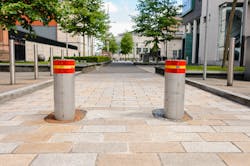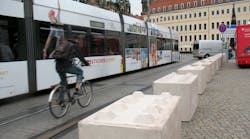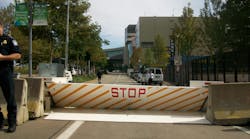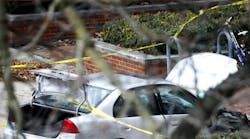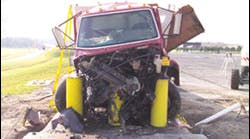The menace of deadly vehicle-ramming challenges security professionals
The specter of vehicle-ramming incidents that achieve mass casualties and death is not a new phenomenon. Such occurrences have been a global threat for more than two decades. Since 2006, there have been at least 15 reported terror attacks involving vehicles that have been weaponized by terrorists and radical groups around the globe, killing at least 151 people. Most of the deadliest vehicular terror assaults have been limited to Europe, with the horrific July 2014 attack in Nice, France, at a Bastille Day fireworks display being the most notable. A Tunisian ISIS convert turned a 20-ton rental truck into a crowd, striking and killing 86 people. Berlin, Stockholm and Barcelona have all incurred multiple-casualty events in the past six years. In the late spring and summer of 2017, London was battered by three separate vehicle-ramming attacks in the heart of the city accounting for at least 14 deaths.
North American terror attacks of this kind have been more isolated. Three such incidents grabbed headlines in the United States, beginning in March 2006 when an Iranian American student drove his SUV into a busy student plaza at the University of North Carolina at Chapel Hill, injuring nine. But it wasn’t until 2016 that terror struck another American college campus as a man, also inspired by ISIS, conducted a vehicle and knife attack at Ohio State University, injuring 11 students. A year later on a bike path near the World Trade Center in New York, a man influenced by ISIS rhetoric killed eight people and injured a dozen more by barreling a rented pickup truck through a crowd.The most frightening aspect of this type of vehicular assault is its growing frequency and startling brutality related to non-terror incidents. The reality is that car-ramming events occur almost every day, so says a recent report published in 2018 by the Mineta Transportation Institute’s National Transportation Center at San Jose State University, adding that most of these are not vehicular assaults by terrorists, but rather rammings by criminals, drunks, drivers overcome by road rage or persons in the middle of arguments by drivers who deliberately crash into other cars, try to run over antagonists, and, increasingly, try to ram police cars.
The Deadly Face of Vehicle-Ramming
Just last month, a Christmas celebration in the small Milwaukee suburb of Waukesha saw a scene that its mayor described as “Norman Rockwell type of Christmas parade” suddenly degenerate into a spectacle of horror and mayhem. A man who had recently been released on $1,000 bond stemming from criminal charges of attempting to run over the mother of his child at a Milwaukee gas station, crashed through makeshift barriers on Main Street’s parade route, mowing down dozens of people including a group of parading elder women, killing six and injuring 62 others. Police said that the red Ford Escape SUV "appeared to be intentionally moving side to side" and witnesses felt this was "a direct intent to hit as many parade participants as possible". Police added that the suspect had left the scene of a domestic dispute minutes before driving into the parade route.
“Vehicle ramming, in a security sense, is the use of a vehicle to inflict harm on people and things. Vehicle ramming attacks are regarded as attacks on people, but they can also be ramming attacks on facilities. You see that a lot with angry drivers, somebody who's trying to get even with an employer, somebody who's trying to get even with the wife who just served papers. In that sense, it's not very different from the workplace shooting incidents where somebody just got served a restraining order and they come back in and shoot up a place. There are all levels of human activity, and there are no reason vehicles and attacks should be any different,” explains Rob Reiter, a 20-year veteran of the security industry and an expert in perimeter security and preventing vehicle incursions. Reiter, the co-founder of the Storefront Safety Council and Principal at Reiter and Reiter Consulting Inc, is also the Chairman of SIA’s Perimeter Security Subcommittee and co-chairs an ASTM committee working on high-speed anti-terrorist barriers as well as low-speed pedestrian protective barriers.
“If you start at the very top, you have deliberately inflicted vehicle attacks, the most famous of which were the Berlin Market attack and the one in Nice, France, which left dozens killed and several hundred injuries because they (terrorists) were using semis. And then in Denmark, where four died, they did the same thing and drove into a department store. You can use big vehicles or small vehicles to deliberately attack people. When it's an act of terror, terrorism is always about what's your biggest impact? How can we be the most famous? How can we scare everybody the most? That's why the big vehicles are handy for that, but there are places you can't get big vehicles into. So, we have seen a majority of these (recent) attacks being (conducted with) SUVs and smaller pickup trucks,” continues Reiter. “In Europe, especially around the time of Christmas where they have Christmas markets, they (law enforcement) secure what they call the Central Business District. In Waukesha, what you had was a nice, small-town parade that they have probably been doing for 25 years, and probably hadn't changed (security) procedures in 24 years. The city figured that they were doing everything that they needed to do, which is something that you hear almost every police chief say after an event like this – ‘We did everything we knew we had to do.’”
Vehicles are the New Automatic Weapons
In an October 2020 report from the Center for Strategic International Studies (CSIS), a private, tax-exempt institution focusing on nonpartisan and nonproprietary international public policy issues, the research pointed to a disturbing increase in vehicle attacks in the U.S. since the rise of election conspiracy disinformation, COVID-19 and other issues of social unrest that have swept the nation over the last half-decade. The report says the majority of the recent vehicle attacks have targeted demonstrators and most of these were committed by white supremacists or others who opposed the Black Lives Matter movement. The tactic gained traction among white nationalists after James Fields’ murder of Heather Heyer at Charlottesville. CSIS data shows that from January to August 2020, vehicles were used in 11 violent far-right attacks, which accounted for 27% of all far-right terrorist incidents. Surprisingly, this made vehicles the weapons most frequently used in far-right attacks. This marked a significant increase from 2015 to 2019, during which a vehicle was used in only one violent far-right attack.
According to CSIS, “this spike in vehicle attacks may have been caused by the ease of using a vehicle to target large gatherings, such as protests. As a Department of Homeland Security assessment concluded, ‘Attacks of this nature require minimal capability, but can have a devastating impact in crowded places with low levels of visible security.’”
However, as concerning as the rise in vehicle attacks in the U.S. has become none of them have been as lethal as those in such cities as Nice, France in July 2016, which killed 86 people; Barcelona in August 2017, which killed 16 people; or New York City in October 2017, which killed eight people. The Department of Homeland Security recognizes vehicle ramming attacks as an unsophisticated and low-tech tactical innovation that tend to be successful as they minimize the potential for pre-attack detection by law enforcement while retaining the potential to inflict serious fatalities. It has been called the “poor man’s weapon of mass destruction.”
“Vehicular threats aren’t new. While press coverage is arguably more frequent and gives the impression these threats are on the rise, these risks remain inherent whenever vehicles and people are in close proximity to each other. As security professionals, we understand the acute risks associated with storefront crashes, vehicular attacks and errant vehicles in crowded venues. As practitioners we’re frequently asked for counsel on how to thwart these risks,” says Mark Oakes, who is the CEO of Concentric Security, a perimeter security construction company specializing in those technology and service solutions required to physically protect facilities, their occupants, and visitors against terrorist attacks and has more than 37 years of experience in the planning, design and construction of physical security construction projects. “While I understand the heightened sensitivity, it’s important to weigh these risks alongside all risks and design mitigation strategies that cover as broad a risk landscape as possible. This isn’t just a security problem. It’s a safety problem as well.”
Social Climate Leads to Deadly Encounters
With increased social unrest and more aggressive social protests, whether it's Black Lives Matter, abortion rights, pipeline demonstrators or energy advocates, there seems to have been open season declared on protestors who decide to position themselves on active roadways. While most motorists may not approve of the tactic, they do realize that they can be seen in the roadway and that they're protesting. Unfortunately, law enforcement is dealing with increasing incidents of more aggressive drivers going into those crowds trying to disperse them on their own.
Clouding the issue now are several state governments that have moved to create an even more incendiary environment since the George Floyd protests of May 2020 that have documented more than 100 incidents of hostile drivers ramming into activists, including police officers, gun-toting citizens and a Ku Klux Klan leader. Both Republican governors Ron DeSantis of Florida and Oklahoma’s Kevin Stitt have signed off on state laws that essentially grant “civil immunity to drivers who ram into protesting crowds and even injure or kill participants if they claim the protests made them concerned for their own well-being in the moment”.
How Can Mitigation Work?
So how must public safety officials and security experts rethink mitigation strategies to potential vehicle-ramming incidents? For Reister, a commonsense approach would be a good start.
“Crowds are more susceptible than you realize because (these incidents) aren’t just limited to special events. But let's separate it out. Let's take the ones where event planners have taken a street that is designed to move traffic and turn it into an entertainment venue and have them in the middle of the street. When you increase the risk to people of vehicles, you have to increase the protection of people against the vehicles. It's only common sense. Nobody tells their kids to go out and get in the center divider of a freeway and play baseball. And yet, that's essentially what happens,” Reiter asserts. “People presume that they are safe because they figure somebody is doing something (to protect them). And yet, if you go back to 2003 in Santa Monica and 2014 in Austin and 2015 in Stillwater, Okla., and all those other tragedies, the consistent theme was an absence of actually closing off the street.”Santa Monica and Venice Beach have been the scene of two horrific and deadly vehicle-ramming events. In 2003, an elderly driver mistakenly stepped on the gas pedal instead of his brakes as he was doing more than 80 miles per hour and plowed into the middle of an outdoor farmers market in Santa Monica. Ten people were killed and more than 70 were injured. This was an unintentional tragedy, but poor public safety measures only exacerbated it. However, there was criminal intent when a man rammed his car into crowds strolling the Venice Beach boardwalk in August 2013. The attack killed an Italian woman on her honeymoon and injured 11 others. The driver turned himself in to the police hours later.
“Putting up a sign that says street closed is not the same thing as closing the street. You're not closing it to traffic. In Santa Monica, whether it was a psychotic driver or just a driver with a lack of awareness, he drove a thousand feet down that street, and he killed 10 people and put 70 in the hospital. He got out of his car and said, ‘Why didn't you guys get out of my way?’ You should never let a car drive a thousand feet down into a crowd. That's why you put barriers in, but they didn't have any barriers anywhere. The MTSB report about Santa Monica concluded that they should have put in rigid steel barriers such as bollards to close off a street. If people are in there, they have a presumption of personal safety and you must remove vehicles from a pedestrian-only area,” concludes Reiter.
Oakes adds: “Technologies and mitigation strategies (bollards, barriers, architectural/landscape design, CPTED, etc.) are good tools but… they are only tools. These tools represent one element of a well-designed security system. The components of any security system are People, Procedures and Equipment (Technologies). We must weigh each component and create a well-balanced system designed to mitigate what we perceive as being the most likely risks.”
About the Author: Steve Lasky is a 34-year veteran of the security industry and an award-winning journalist. He is the editorial director of the Endeavor Business Media Security Group, which includes magazines Security Technology Executive, Security Business and Locksmith Ledger International and top-rated webportal SecurityInfoWatch.com. Steve can be reached at [email protected].

